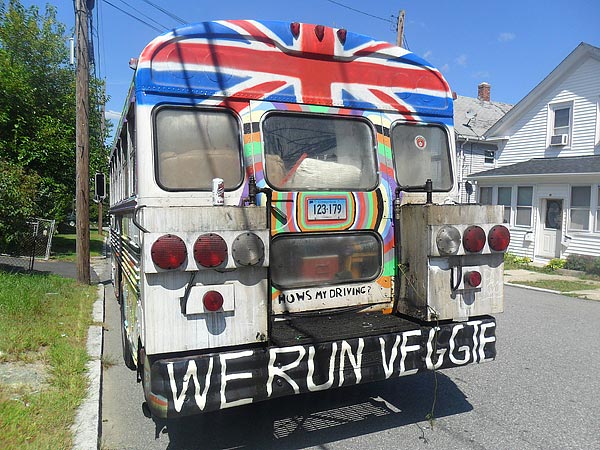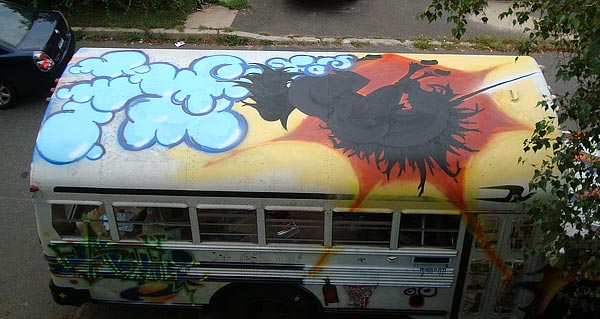Michael Vaughan and his friend John live in school buses that run on veggie oil that they’ve converted into RVs. Both buses run on used vegetable oil and have a refinery on board the bus so that they can put any oil in their “bulk tanks” and filter it into their “day tanks” while on the road.
Michael’s has a refrigerator, sink, bed, and two couches. There is a solar panel on the top that he can use all the electricals on board the bus (fridge, lamps, laptop, etc.). Michael lived in his bus full time last summer and both he and John are planning on living in their bus full time this summer and tour the festival circuit (they would do it full-full-time if we weren’t currently in school).

Both conversions were done by Joseph Hollay of Cheney Technical High School in Manchester, CT for around $1,000.

Michael explains below how the system works.
Alright, basically the way the veggie systems work is we have a big tank called the bulk tank for putting any kind of vegetable oil in. Since we mainly use use vegetable oil because its free or incredibly cheap (at most it costs around $0.25/gallon), the bulk tank is used for mass storage. It then goes through a series of filters, first two wire mesh screens, then a 15-micron fuel filter, then a 10-micron fuel filter to get all of the contaminants, water, chunks, etc. out of the oil. It is pumped through these filters using a standard fuel pump that are usually used for pumping fuel just like at a gas station. Once it is through the filters, it is pumped into the second tank called the day tank that is used like a normal fuel tank on any car.
We then run the fuel line along the length of the bus along coolant lines to heat it up enough to be used in the engine. The way it is pumped along the coolant lines is simply that the engine itself causes enough suction.

The veggie line then is put into the diesel line with a shutoff valve for when we want to run straight veggie or a mix or straight diesel. Therefore when we have the shutoff valve on, the engine uses veggie and when it is off it uses diesel. The only thing that makes there a need for conversion for running veggie is the contaminants and the thickness of the oil, which is why we run the veggie line along the coolant lines to heat it up and thereby make it less thick.
You can see more photos and learn more about their buses at Juan Way Tour.


Beautiful!!!!!!!!
Think I saw this bus/RV at the Tweed River Festival (Bow Thayer’s place) in VT last year (2010) – I was taking a close look since I’m into the veggie/biofuel thing (got an ’01 F250 that has a Greasecar kit & run my ’83 300SD on locally-made biodiesel)
Keep up the great work!
Yeah, we were at Tweed River in 2010, and we’ll hopefully be there again this year. Out of curiosity, do you know Michael from Michael’s Good to Go in Waitsfield? He has a bus that runs on vegetable oil too, and he hooked us up with some amazing oil. We’re touring the festival circuit this summer and Tweed River is the last festival we’re hitting (the order we’re going in is Wakarusa, Bonnaroo, Electric Forest, Grey Fox, and Tweed River).
Michael,
I am a new owner of a bus myself. Is there any way I can chat with you in more detail about the project I am using the bus for, and how to get on veggie myself? I will be in CT soon by the way. I would love to connect. kamh2os@gmail.com or kam@avocadoarmy.com
Thanks.
They are cool, but are they tiny houses? May be when they have been lived in, and there for modified for living in, we could re visit them.
Hi, at beginning of article, it says they are being lived in and that one has sink, refrigerator… 🙂
I’ve lived in busses that were less set up than these, it all depends on how you’re able and willing to manage the basic functions. It isn’t necessary to have conventional sink, kitchen, toilet, bed etc. Dishes can be washed in pails or bowls, food cooked outside on fires or camp stoves, you can sleep in a hammock, on a bed of nails or whatever suits you. Aesthetics may be as much about prioritising time and resources as about personal taste. If you live in something that may not be everybody’s notion of a house, but it works for you (within certain health and safety standards) it’s your home, which is really what housing should be all about. Besides which, showing the possibilities of the fuel system is a very worthy subject and may provide someone else with inspiration.
Wow, that’s a pretty intense conversion.
it is true beauty and functionality is in the eye of the beholder.I to owned a 35 ft school bus and lived in it of grid.You cry small house foul? I see inovation, inspiration,ingenuity and imagination. Oh and a small house.Well done!
My son thinks this is totally cool, love the artwork! I know what his first car is going to be now…..
I love buses! I’ve lived in a couple of them and there is no better way of life! Love the info on vegetable oil for fuel.
Very cool/damn fun n’ creative- congrats to you guys!
These guys from CT?
Great stuff Kent- I might have to reblog on this and link you, etc….
-Deek
Relaxshacks.com
Go for it Deek, might be a good resource for your next book too.
Yeah, and/or invite these guys to my MA workshop, or the next one, etc- too fun!
-Deek
I’m Mike and this is my bus. I’m a bit late on this, but just sayin’ I’d love to work with you at one of your workshops. Tiny Houses are a huge interest of mine but outside of my bus, I have very little practical knowledge about them (most of what I know about them comes from this blog). Also, for people who don’t think this qualifies as a tiny house, I can see where you’re coming from considering I only live in it during the summer and it has no toilet or shower. To combat this, I usually just use stores like Wal-Mart to park in and use their facilities (and fore-go the showering). The cooking was done with a propane camping stove and the washing up was done with the sink that is in the bus.
LOVE IT!!! It seems very obvious to me that these make wonderful homes, for anyone, especially two young guys! Way to go fellas, I think they are lovely/smart living spaces! Safe and happy travels!
I love the idea of a WVO school bus RV conversion, but I’m concerned that it’s not feasible anymore given that petroleum costs have gotten worse in the last few years which is driving corporations, recyclers, farms, etc to seek out biodesel alternatives. It’s making acquisition of cheap veg oil nearly impossible from restaurants without going to a middle man or establishing a metro-wide co-op/business. It’s especially harder for school buses which typically get 10mpg and need 100-200 gallons at a time. A VW/Benz getting 30-50mpg and needing 20 gallons is probably feasible, but a school bus’ needs doesn’t seem so unless there is some corporate/co-op effort. I’d like to convert my bus/RV to WVO but the conversion doesn’t make sense if I can’t get any WVO cheaper than diesel!
Very cool. We love our converted school bus. We used it as a home, not for travel per se, though it is nice to be able to move it fore site to sit.
interested in buying the bus…hit me up if its not sold.
love it. well none. freeom speaks. i live in a international thomas 36 foot with a 345 engine and a 4 speed allson auto built 1973 canada very strong and heavy 22.5 tons . iam 71 and been in this bus for 22 years. i use a wood fire for heat. 5 gallons of propain a year for cooking and i cook a lot. solar panels on top to run the radios vidios tablets. portajohn works the best. bath is pour over your head and body with water and soap. fun and easy. dont buy cold food. like fresh. no built ins. like to move my stuff around from time to time. so i can built bikes or what ever. being a single person with four dogs it was my best investment. right now its parked in douglas arizona at 95 17th street on a lot for 50 dollars a month . yes i have live all over the americas. mobil is life. email ywilliamnewton@aol.com or you got the address. see you